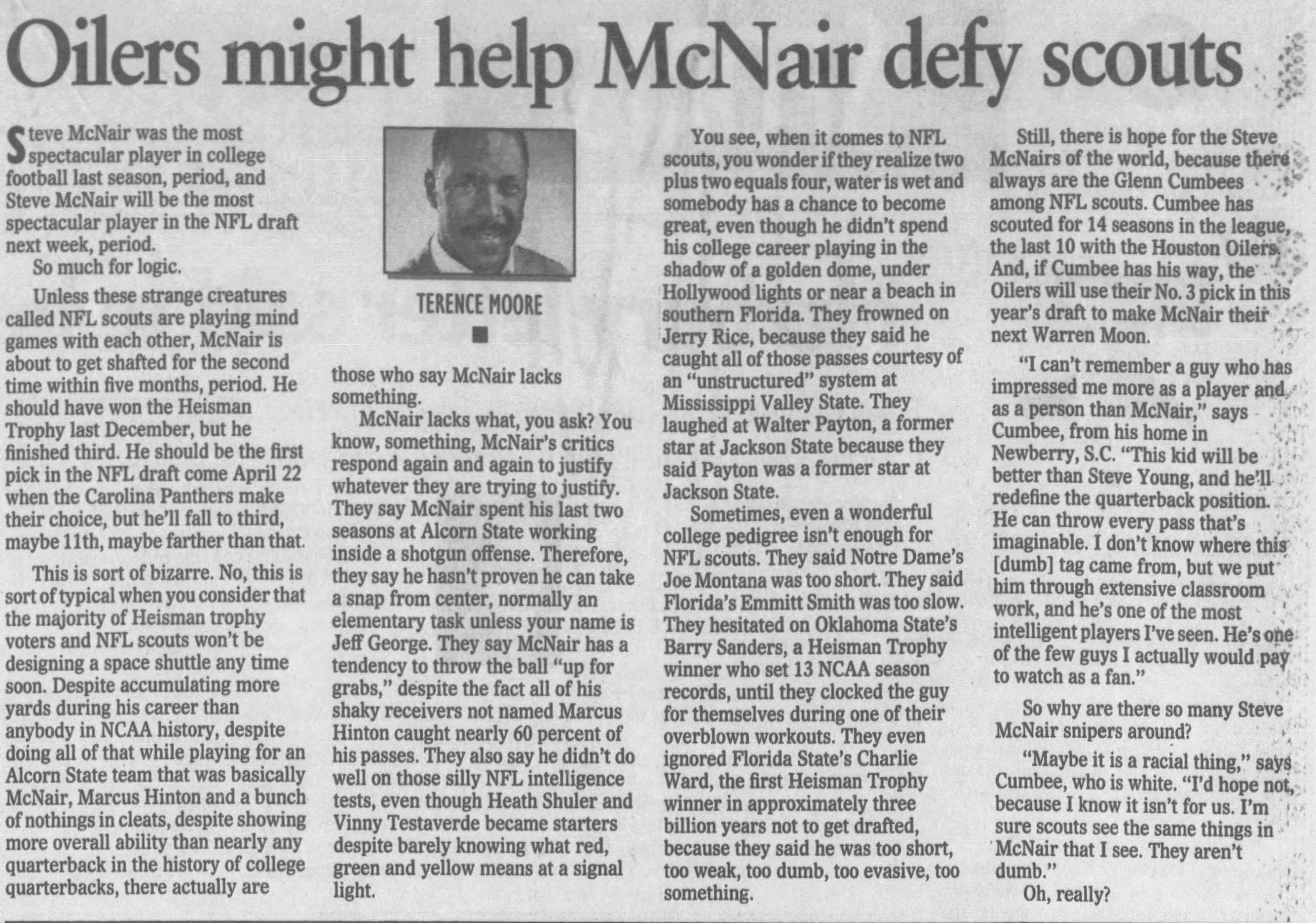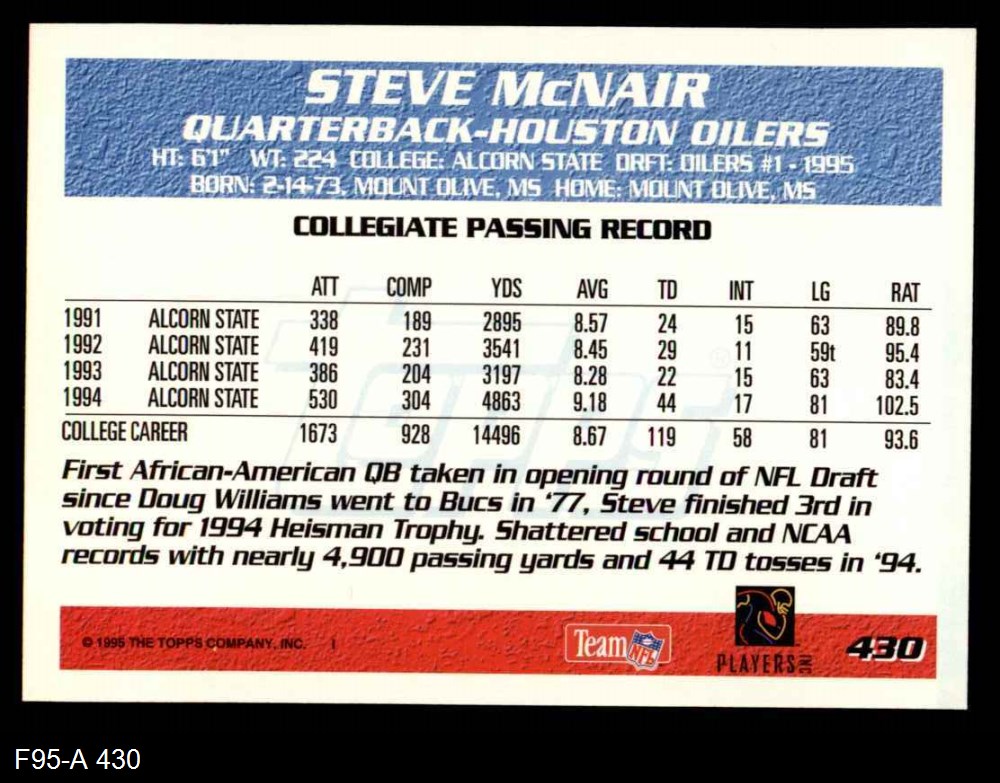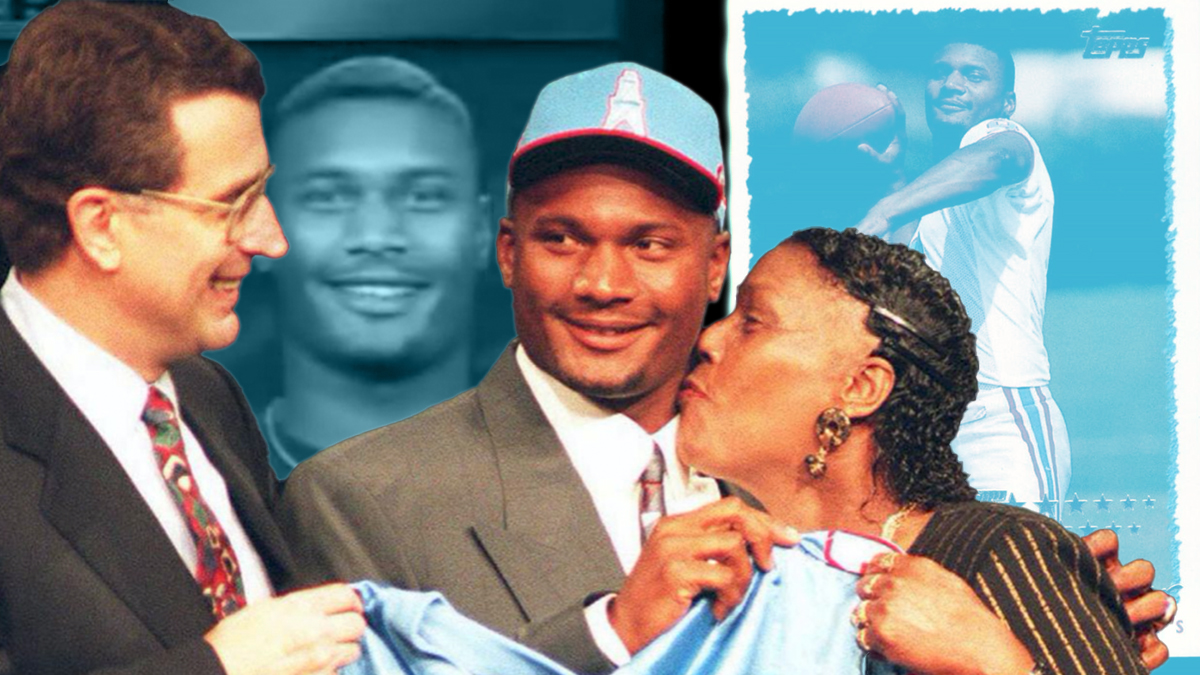It’s been fourteen years since the world tragically lost former Alcorn State quarterback and first round draft pick Steve McNair. The former Houston Oiler and Tennessee Titan was killed in a murder-suicide in 2009 in Nashville. Our Steven J. Gaither tells the story of McNair and his journey to the 1995 NFL Draft with this article from 2020.
Overcoming the odds
The 1995 NFL Draft was one that ultimately helped shape the league for the better part of a decade-and-a-half. It was a draft, like most, filled with both busts and overachievers, and some who just were what they were.
But that year’s draft was historic because it featured a once-in-a-generation quarterback prospect from a historically black college that elevated himself above Power Five players in the minds of some NFL analysts and scouts, and more importantly, at least one NFL franchise.

The Carolina Panthers held the top pick in the draft, with their fellow expansion team Jacksonville Jaguars holding down the second spot.
Running back Ki-Jana Carter of Penn State was thought to be the draft’s top talent, but there were several other very talented players in the draft. Offensive tackle Toni Bosseli defensive end Kevin Carter and defensive tackle Warren Sapp were among some of the other highly regarded players.
Tale of two quarterbacks
Then there were the two quarterbacks that people thought had the potential to be franchise players. There was Penn State’s Kerry Collins, who had just led his team to a perfect season in 1994. He was a pocket passer from a Big Ten school with the “big-time” pedigree that has suckered many a scout into choosing the wrong quarterback. He had the look and feel of what a franchise quarterback was (and to some extent still is) supposed to be.
And then there was Steve “Air II” McNair from tiny Alcorn State. McNair had just completed a career in which he owned just about every Division I-AA (now FCS) record and finished third in Heisman Trophy voting despite playing at a lower level. He threw for 14,496 yards and 119 touchdowns, 44 of them thrown his senior season.
Still, despite strong performances in all-star games, the buzz prior to the draft was that Steve McNair– stop us if you’ve heard this before – possessed all the physical tools but perhaps wasn’t smart enough to be a franchise quarterback. Some had him falling out of the top 10 of the draft.

“This kid will be better than Steve Young…”
Terrence Moore, a long-time reporter, and columnist for the Atlanta Journal-Constitution had seen it all play out before. The week before the April 22nd draft, Moore wrote a column called “It should be a snap,” pointing out how scouts were using an unfair, but not unfamiliar, tactic to try to downgrade McNair’s stock.
“They frowned upon Jerry Rice, because they said he caught all of those passes courtesy of an “unstructured” system at Mississippi Valley State. They laughed at Walter Payton, a former star at Jackson State.
One scout Moore mentioned was Glenn Cumbee who worked for the then-Houston Oilers. Cumbee raved McNair with high praise.
“This kid will be better than Steve Young, and he’ll redefine the quarterback position. He can show every pass that’s imaginable. I don’t know where this (dumb) tag came from, but we put him through extensive classroom work, and he’s one of the most intelligent players I’ve seen. He’s one of the few guys I would actually pay to watch as a fan.”
Long-time NFL Draft analyst Mel Kiper Jr. had Steve McNair as his top-rated quarterback, stating that McNair could be “spectacular” in four years. But the day before the draft he noted that several teams seemed to have moved Collins ahead of McNair on their draft boards, due to his ‘low-key approach and quiet demeanor.”
Kiper speculated that he could fall as low as 11 to Minnesota, who was looking for a potential replacement to Warren Moon.

Saturday. April 22, 1995. New York City
Finally, the big day had come. The Panthers kicked the day off by officially trading out of the first overall pick, handing it to the Cincinnati Bengals.
The Bengals were one of several teams that coveted Penn State running back Ki-Jana Carter, and they were willing to give up several picks to compensate. The Panthers, meanwhile, were locked in on getting a quarterback. And everybody knew there were only two to choose from.
From the beginning, Panthers GM Bill Polian made it clear that he was concerned about the level of competition he’d played against.
“He’s a great athlete with terrific arm strength and the ability to avoid (pass rushers) in the pocket,” Polian told The Journal News prior to the draft. “The only real downside is that he’s played at a low level of competition and he’s making a huge jump to the NFL in the premier position.”
“The one thing you don’t know is how he’ll handle the sophisticated, faster-by-a-lot-defenses in the NFL.”
The Jaguars, unlike their expansion brethren, weren’t pressed for a quarterback. They had already picked up a promising young quarterback in Mark Brunell in the expansion draft. Brunell had shown enough promise as Brett Farve’s backup that they were more focused on getting an offensive line to support him. They selected Boselli, who would go on to play at a Hall of Fame level during his career.

‘The Michael Jordan of the Draft’
Former Washington Redskins quarterback Joe Theisman was especially high on McNair. The on-air analyst gave McNair the edge in Arm Strength, Mechanics, and Athletic Ability, while he gave the edge to Collins in Pocket Presence and System Preparation. He rated both players as a 34 based on Deep Passing, Touch Passing, Rolling Out and Reloading.
“He is raw around the edges, I’ll give you that,” Theisman said looking into the ESPN cameras. “Maybe that comes out of the competition in the Division II schools where it isn’t like it would be in Division I.”
Never mind the fact that the SWAC was a Division I-AA school.
“He’s just too darn talented to pass up. He’s the kind of guy you have to have.”
Then Theisman eerily plotted out the first couple of years of McNair’s career, predicting he’d sit as a rookie, play a little over the next few seasons and be ready to start by 1997.
“You’re investing some money in a young man, but he’s certainly the kind of guy you’re willing to spend some time on. Because he is, and could well be, your franchise quarterback.”
Theisman was convinced that Steve McNair would be able to develop under the tutelage of then-Oilers offensive coordinator Jerry Rhome. Rhome coached Theisman in Washington and had also been crucial in the development of Troy Aikman, who was about to win his third Super Bowl in four years.
Ironically, according to Chris Mortenson, Rhome wanted the team to draft receiver Michael Westbrook over McNair.
However, Oilers general manager Floyd Reese was convinced that McNair was “the Michael Jordan” of the draft and that he could get the team over the hump. In the end, Reese won out.
11:40 AM
Commissioner Paul Tagliabue was ready to announce the Oilers pick. The cameras zoomed in on McNair in the green room as the Commish announced the Oilers selection.
“With the third choice in the first round, the Houston Oilers select quarterback from Alcorn State: Steve McNair.”
McNair, surrounded by family and supporters, looked down, stood up and flashed his 1000-watt smile for the entire nation to see as he was engulfed by hugs.
“They had the guts to pull the trigger,” exclaimed ESPN’s Chris Berman, rattling off his college statistics “I don’t care who he’s playing against, Joe – that’s unbelievable.”
Theisman praised McNair’s athletic ability, mechanics and toughness as the nation watched his highlights. He compared the newly drafted quarterback to John Elway, which was very high praise.

“He may be raw around the edges, but diamonds are as well before they become very valuable stones.” Joe Theisman on Steve McNair
Choosing Alcorn comes full circle
For McNair and his family, it was a moment years in the making. His brother, Fred, had been a star at Alcorn State, but never made it to the NFL. Steve himself had been asked to move to defense by Division I-A schools before following his brother’s lead. Now he was not only a first-round pick, but the highest ever drafted black quarterback in history at that point.
“I’m glad this process is over with,” McNair admitted. “I can concentrate on doing the things I’ve got to do to prepare to be the quarterback in Houston.”
And, of course, he gave a shoutout to the home team.
“I couldn’t have did it without the teammates back home at Alcorn State University, the coaching staff also. It’s those guys that makes me the quarterback I am today.”
The long arms of Doug Williams
When asked if there were any pros he had reached out to in preparation for the draft and his pro career, he reached across the SWAC and pulled out a name that pretty much everyone at home would know.
“Doug Williams, being in the SWAC, being in the league and being a Super Bowl MVP– he’s really led the way. He made it easy for me, telling me how to cope with the things that’s gonna be (involved) as a quarterback in the National Football League.”
Indeed Williams had been in McNair’s shoes two decades earlier. Williams made his mark playing for the legendary Eddie Robinson at Grambling State, where he also garnered Heisman votes during his senior season. He was selected 17th overall by Tampa Bay, whom he spent the first part of his career with before going to the USFL and eventually becoming a Super Bowl MVP with the Washington Redskins.

Expectations were high in Houston. New coach Jim Fisher said he planned to bring McNair along slowly despite his obvious talents.
“Steve is going to be in our eyes a franchise player, a franchise quarterback,” Fisher told the media after the draft. “He’s been the guy for quite some time. As you go through this process you evaluate the players by position. Steve has been our guy. We’ve been more convinced during the workout.”
Oilers owner Bud Adams saw his new quarterback surprising a lot of people, including his new head coach.
“I think Steve McNair is going to surprise all of you out there,” he said after the draft. “I think everyone says he’s going to need to take his time, but I think this guy is going to step in there and be a starting quarterback quicker than most people think.”
New City, New Opportunity
Their words, of course, would eventually come true. His first two seasons saw only mop-up duty or filling in when Chandler was hurt, making six starts during the team’s last two seasons in Houston.
His first season as a starter came in 1997 with the move to Tennessee. He improved steadily over the next two seasons as the team maintained the Oilers name and colors while shaping a new identity with McNair and running back Eddie George as the faces of a new franchise: The Tennessee Titans.


And the rest, as they say, is history.
Trend was born
Four years after McNair’s selection, three African-American quarterbacks were selected in the first round of the 1999 NFL Draft: Akili Smith, Donovan McNabb and Dante Culpepper. Five years later, Mike Vick went number one overall.
A quarter-century later, McNair is no longer the highest-drafted black quarterback, having been surpassed by Vick in 2000. He remains, however, the highest-drafted quarterback from a historically black college to be selected in the NFL Draft.
And based on the fact that only two HBCU quarterbacks have been drafted since (FAMU’s Ja’Juan Seider in 2000 and Alabama State’s Tarvaris Jackson in 2006), it appears he may hold on to that record for all time. In a perfect world, McNair’s success would have meant more top-flight quarterbacks would give HBCUs a chance. In the real world, McNair’s success on the college and ultimately the pro level opened a door for more players like himself to get a serious look from Power Five conference schools and become high draft choices.
These days we in the HBCU community often talk only about what McNair’s career meant for HBCUs. In truth, he opened the doors for the Cam Newtons, the Jameis Winstons, the Patrick Mahomes, the DeShaun Watsons and all the other quarterbacks who didn’t go to HBCUs. Of course, Warren Moon and Randall Cunningham were already proven veterans in the league at this point, but neither of them were first-rounders.
Both Moon and Cunningham went to PWIs, but in the end, it was a young man from Alcorn State to prove to the NFL that spending a first-round pick on an African-American quarterback wasn’t any riskier than spending one on a White one.
